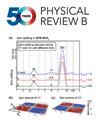重正化密度矩阵折叠:从多体计算中学习新兴模型的严格框架
IF 3.7
2区 物理与天体物理
Q1 Physics and Astronomy
引用次数: 0
摘要
我们提出了一个广义框架--重归一化密度矩阵折叠(RDMD),以从原子序数计算中推导出系统改进的、高度精确的非微扰有效模型。这一框架超越了演算法在计算拟议哈密顿参数中的常见作用。取而代之的是,RDMD 能够决定是否能从原子序数数据中识别出给定的有效希尔伯特空间,并评估拟哈密顿的相对质量。任何从头开始求解的方法都可以用作数据源,随着从头开始求解的改进,结果模型也会随之改进。我们在氢链向自旋模型下折的应用中演示了这一框架,在这一应用中,我们找到了即使在标准方法失效的强耦合机制中也能做出非微扰映射的原子间分离,并计算出了定量再现了 ab initio 动力学的重规范化自旋模型哈密顿。本文章由计算机程序翻译,如有差异,请以英文原文为准。
Renormalized density matrix downfolding: A rigorous framework in learning emergent models fromab initiomany-body calculations
We present a generalized framework, renormalized density matrix downfolding (RDMD), to derive systematically improvable, highly accurate, and nonperturbative effective models from ab initio calculations. This framework moves beyond the common role of ab initio calculations as calculating the parameters of a proposed Hamiltonian. Instead, RDMD provides the capability to decide whether a given effective Hilbert space can be identified from the ab initio data and assess the relative quality of ansatz Hamiltonians. Any method of ab initio solution can be used as a data source, and as the ab initio solutions improve, the resultant model also improves. We demonstrate the framework in an application to the downfolding of a hydrogen chain to a spin model, in which we find the interatomic separations for which a nonperturbative mapping can be made even in the strong coupling regime where standard methods fail, and compute a renormalized spin model Hamiltonian that quantitatively reproduces the ab initio dynamics.
求助全文
通过发布文献求助,成功后即可免费获取论文全文。
去求助
来源期刊

Physical Review B
物理-物理:凝聚态物理
CiteScore
6.70
自引率
32.40%
发文量
0
审稿时长
3.0 months
期刊介绍:
Physical Review B (PRB) is the world’s largest dedicated physics journal, publishing approximately 100 new, high-quality papers each week. The most highly cited journal in condensed matter physics, PRB provides outstanding depth and breadth of coverage, combined with unrivaled context and background for ongoing research by scientists worldwide.
PRB covers the full range of condensed matter, materials physics, and related subfields, including:
-Structure and phase transitions
-Ferroelectrics and multiferroics
-Disordered systems and alloys
-Magnetism
-Superconductivity
-Electronic structure, photonics, and metamaterials
-Semiconductors and mesoscopic systems
-Surfaces, nanoscience, and two-dimensional materials
-Topological states of matter
 求助内容:
求助内容: 应助结果提醒方式:
应助结果提醒方式:


